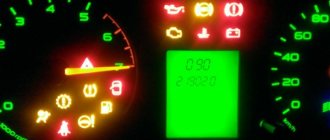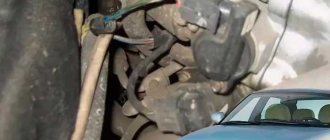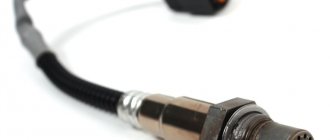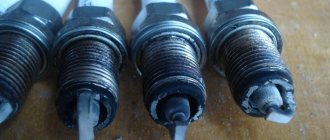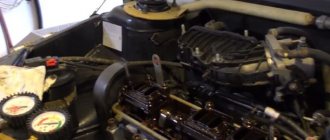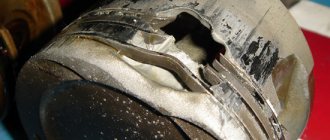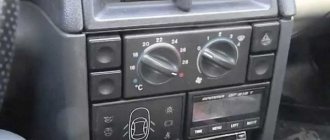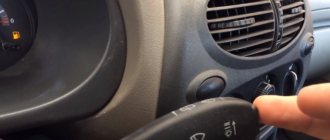Why does the “check” light up: the most common and common malfunctions
So, we figured out the general scheme. Now let's look at what problems lead to the check light coming on and the engine stalling. Often a p0300 error occurs, which indicates that a misfire (misfire) is occurring. There are several reasons for these omissions, and to determine them it is necessary to carry out a step-by-step diagnosis, taking into account certain individual symptoms.
You should start by checking the ignition system. The most common cause of tripping is the failure of spark plugs and armored wires. Candles can wear out their service life, break down, or become heavily contaminated. Armored wires suffer from insulation damage and breakdowns. One way or another, the result is either no spark at all, or there is a spark, but it’s weak.
If everything is in order with the spark plugs and wires, you should pay attention to the ignition module or ignition coils, which may be shorting. In this case, it is better to entrust the check to experienced specialists, since unprofessional actions lead to the fact that you can burn the switch or damage other important elements
It should also be added that you need to carefully inspect the spark plug wells themselves. Quite often, the engine fails if water accumulates in the wells or engine oil gets there. In some cases, lubricant gets into the wells due to problems with the valve cover gasket.
Having dealt with the ignition system, it is necessary to check the power system. As a rule, incorrect operation of injection nozzles or malfunctions in their operation lead to engine tripping. At the same time, the check will light up or flash.
The best option would be to check the injectors on a special stand. Such diagnostics allows you to determine the need to clean, repair or replace injectors. At the same time, specialists check the power supply to the injectors, the condition of the injector O-rings, etc.
As for compression, a burnt-out valve often leads to an unexpected decrease in the indicator. If the valve burns out, the engine starts to run rough. In this case, tripling is constant and occurs in all modes of engine operation. Engine thrust drops significantly, and significant excess fuel consumption is observed.
Please note that in this case you cannot drive the car, as there is a high risk of damaging the catalyst and oxygen sensor (lybda probe). To confirm the diagnosis, you need to measure the compression, and to solve the problem itself, you need to remove the cylinder head, troubleshoot the head and change the valve.
How serious can the reasons be?
Each signal on the car panel is an indicator that the driver must be attentive. When the check engine light comes on, there are several reasons.
- A common cause is gasoline. Due to the additives that unscrupulous manufacturers use in gasoline, the engine does not work properly and becomes clogged. You should change the fuel or refuel at another gas station, and everything works correctly.
- Faulty spark plugs.
- Broken ignition coil.
- A faulty oxygen sensor (lambda probe).
- Broken exhaust catalyst.
- Incorrect operation of high-voltage conductors.
- Malfunction of injectors.
- Fuel pump or fuel filter.
The check should begin with the fuel tank filler cap. If it is not tightened completely or there are defects on it, then the light indicates that the engine is not operating properly.
Each of the reasons is not very scary, but requires immediate elimination. If you do not pay attention in time and do not diagnose the malfunction, you can lead to complete engine failure and incapacity of the machine.
The engine is serious business, but the job doesn't necessarily require a major overhaul or engine replacement. The work of the craftsmen is important in any matter of diagnosing and repairing the engine. But, if the reason is candles, then the replacement is carried out independently and quickly, without the involvement of specialists.
Auto electrician website. Repair practice, electrical circuits, etc.
So, you have purchased a good, unpretentious car - a VAZ. But at one fine moment, the “Check Engine” icon lit up on the dashboard of your car, the literal translation is “check the engine”, in the slang of auto mechanics - “throw out the engine”, “meat grinder”, “check”, etc. (applies only to injection cars - Priors, Kalinas, etc.) The “check engine” icon itself, which does not go out after starting the engine, indicates a malfunction or electrical malfunction in the electronic engine control system (ECM). Many irresponsible citizens believe that in a domestic car the “check” should always be on, but this is not true; in a working car, no yellow or red indicators on the instrument panel should be on.
What malfunctions of the engine control system light the check?
A malfunction of the air flow meter MAF (mass air flow sensor) can light up the check lamp, errors P0102 or P0102, and a faulty flow meter also leads to such troubles as uneven engine operation, lack of acceleration dynamics, and high fuel consumption. As the name suggests, this sensor measures the amount of air entering the engine intake manifold and, based on this data, the control unit calculates the required amount of fuel. In general, this is the most important sensor in the engine control system; a lot depends on its readings. The air flow meter can either completely fail or distort the readings, which will lead to improper engine operation. A malfunction of the mass air flow sensor cannot always be easily diagnosed; the easiest way to diagnose it is to replace it with a known good one, taken from a neighbor. Connection diagram for VAZ mass air flow sensor.
A faulty intake air temperature sensor (built into the mass air flow sensor) causes errors P0112 or P0113. The air temperature sensor readings are used by the control unit to adjust the fuel mixture depending on the outside air temperature. The temperature sensor cannot be replaced separately from the air flow meter.
Malfunction of oxygen sensors , both front (before the catalyst) and rear (after the catalyst). Malfunctions of oxygen sensors can be different, such as an open heating circuit (easily diagnosed with a multimeter), or such malfunctions as a slow response of the sensor due to aging or poisoning with low-quality fuel, which often do not cause the check to ignite, greatly affecting fuel consumption, vehicle dynamics, difficult to diagnose.
A malfunction of the catalyst “low catalyst efficiency” lights up the “check” lamp and has a slight, practically no effect on the behavior of the car. What is a catalyst and why is it needed?
A malfunction of the coolant temperature sensor causes the check ignition and errors P0117 or P0118, depending on whether it is a break or short circuit in the sensor or its wiring. It can be easily diagnosed with a multimeter; the repair manual gives the reference resistances of the sensor at different temperatures.
A malfunction of the throttle position sensor will lead to errors P0122, P0123 and emergency operation of the engine; the serviceability of the throttle position sensor is checked with a multimeter.
Lean mixture - error P0171 has many possible causes, first of all, low fuel pressure and further possible causes are clogged fuel injectors, air leaks, a malfunction of the air flow meter, a malfunction of the ignition system. We consistently diagnose all these reasons. For example, in this case the fuel pump turned out to be faulty.
Rich mixture - error P0172 may be due to a malfunction of the fuel pressure regulator (high pressure in the fuel system) we check by measuring the fuel pressure, leaking fuel injectors, faulty air flow meter, faulty oxygen sensor, stuck canister purge valve, problems with engine mechanics.
Broken fuel injector - errors P0201, P0202, P0203, P0204, the last digit is the number of the cylinder with the malfunction, the faulty cylinder does not work.
Fuel pump circuit malfunction - error P0230, this error indicates a break not in the fuel pump, but in the primary circuit of the fuel pump relay, most often the cause is an alarm lock or anti-theft lock.
Misfires - errors P0300, p0301, P0302, P0303, P0304. It is more correct to say misfires; using the crankshaft position sensor, the engine control unit measures the angular acceleration of each cylinder; if acceleration does not occur in this cylinder, “the counter is triggered,” when the counter overflows, the check light comes on or starts flashing with the corresponding errors. The most common cause is a malfunction of the ignition system - here the ignition coil turned out to be faulty.
A faulty knock sensor lights up the check with errors P0326, P0327, P0328. If the knock sensor malfunctions, the control unit goes into emergency operation mode and sets a safe (late) ignition timing angle. Affects dynamics and fuel consumption.
Crankshaft position sensor malfunction - error P0335. We check the crankshaft position sensor with an oscilloscope. In this case, the sensor stopped working after the engine warmed up.
Malfunction of the camshaft position sensor - error P0340, checked in the same way as the crankshaft position sensor.
P0500 - a malfunction of the vehicle speed sensor leads to decreased dynamics and increased fuel consumption.
Malfunction of the canister purge valve - error P0443, does not affect engine operation unless it is stuck open. The car's fuel tank is sealed, fuel vapors are collected in the canister and, when the engine is running, through the canister valve they enter the engine intake manifold, where they burn together with the working mixture.
Well, electrical wiring faults happen in these beautiful, moderately reliable cars; they manifest themselves in different ways, such as blown fuses due to a wire from the oxygen sensor stuck to the exhaust pipe, or torn wires from the crankshaft sensor, etc.
Throttle Position Sensor
The sensor is responsible for the entire process of engine operation in acceleration, driving at a uniform speed and deceleration. The sensor is responsible for monitoring several engine modes, so it is extremely sensitive to the effects of electromagnetic fields and requires constant preventive maintenance, which can be carried out independently.
The sensor is usually located on the side of the engine and consists of two sensors, which are interconnected with the driver’s gas pedal through the computer. If the sensor is adjusted normally and the Check Engine lights up due to this reason, then it signals the owner about engine malfunctions. Indirect reasons may be: decreased power, increased fuel consumption, on cars with automatic transmission – characteristic “jerking” when switching gears, uncertain engine starting, “dips” during acceleration, increased idle speed. Ignoring this can result in serious engine damage, so you should immediately contact a car service center.
The Check Engine light came on - what to do?
In any case, if the owner sees “Check Engine” on the dashboard while the car is in motion (normally this lamp lights up after turning on the ignition and goes out after a couple of seconds), you need to listen to the engine , then stop and inspect the engine for oil stains and visible damage.
If, apart from the icon, there are no malfunctions in the operation of the internal combustion engine, you can go to a service center and diagnose the problem.
But if strange sounds appear along with the “check” - knocking, humming, creaking from the engine compartment, or the engine “troubles” and noticeably loses power, you need to stop as quickly as possible and call a tow truck.
Continued operation of the vehicle with the “Check Engine” flashing while driving and signs of engine damage may end in disaster.
Why the check engine light came on: reasons and what to do in this case
Let's start with a global problem for the CIS countries. If the “check” light comes on while driving a car after a recent refueling at a gas station, there is a drop in power, the engine begins to work intermittently for no apparent reason, then the culprit may be the quality of the fuel or its inadequacy for this type of engine. Without going into details, the ECU can detect the appearance of detonation in the engine, various disturbances in the combustion process, etc. As a result, the controller signals the driver about a malfunction.
To solve the problem, it is often enough to dilute the fuel poured into the tank with a portion of high-quality gasoline or diesel fuel, after which the burning check will go out on its own after a few km. mileage Let us add that in some cases, low-quality fuel needs to be drained and the power system cleaned. Also, the check may not go out even after the cause has been eliminated. In this case, the recorded error in the ECU must be reset programmatically, that is, using special equipment.
Another reason that the check light is on during operation of the power unit may be engine overheating or low oil level in the internal combustion engine.
In such a situation, you should pay attention to the temperature of the motor. If there is no obvious overheating, then check the engine oil level and its condition
A normal oil level will indicate that the engine can be started and the sound of its operation can be heard. The appearance of extraneous knocking noises in the engine at idle or under load simultaneously with the check light being lit may be a reason to stop driving the car independently. In such a situation, it is better to take the car to a service center for diagnostics without your own power.
We will also touch on the situation when the engine started up and the check light came on. This problem can often be caused by both problems in the ignition system (plugs, wires, coil, etc.) and malfunctions of the power system, when fuel is not injected into one of the cylinders.
If we summarize the main reasons why the check light is on on a cold engine, the engine starts or does not start when the check light is on, then the list should include:
- Low quality fuel that needs to be drained or diluted with normal fuel.
- Broken or heavily dirty spark plugs, incorrect gap between the side and center electrodes. In this case, the spark plugs need to be cleaned and checked, or you can immediately replace the set of spark plugs.
- High voltage wires. Insulation breakdown and contact defects are possible. The spark plug wires need to be checked and/or replaced.
- Problems with the ignition coil. It is necessary to check the coil for a spark, and also measure the resistance at the terminals.
- Irregularities in the fuel supply process associated with faulty fuel injectors. In such a situation, the injector needs to be checked, cleaned or the nozzles replaced.
- Insufficient fuel pressure due to fuel pump failure, contamination of the fuel pump mesh, or reduced fuel filter capacity. In the case of a diesel engine, it is necessary to diagnose the fuel injection pump.
- Catalyst and lambda probe. Failure of these elements leads to the unexpected lightning of the check on the dashboard. On some cars, you can completely remove these elements (cut out the catalyst and disconnect the oxygen sensor), on others you will only need to replace the parts.
- Failure of individual ECM sensors (camshaft position sensor, speed sensor, mass air flow sensor, etc.).
Oxygen sensor
An oxygen sensor is used to estimate the amount of oxygen in the exhaust gases; when it fails, fuel consumption will increase, and there will also be characteristic fluctuations during idling.
In addition to the sensors, the reason why the injector icon on the instrument panel is lit can also be mechanical damage to the timing belt, chain, etc. In general, you need to go to a service center with computer diagnostics or a motorcycle tester; in such a service station they can easily identify the reason why the injector Check light is on. If there is such a service in your city, they will immediately tell you the error code and identify which specific sensor requires replacement.
Video advice on why the injector icon is on:
Elimination methods
To correctly find the problem and fix it, the motorist should have knowledge of the design of the engine and its systems, as well as have the tools. A very indispensable element is time and hands growing from the right place. So, now you can begin to analyze the processes aimed at troubleshooting the problem.
Sensors and ECU
Many car repair mechanics recommend checking the software and meters, of which there are quite a lot in modern cars, before getting into the mechanical part.
So, first you should connect to the electronic engine control unit and carry out diagnostics using special software. The vehicle owner will need a USB-car cable, called K-line or OBD II, a tablet and the appropriate software.
After connecting and identifying the automotive equipment, it is worth carrying out diagnostic operations. If a software failure is detected, it must be removed and the system restored to functionality.
Which sensors are responsible for the normal operation of the engine, and their failure can lead to tripling of the power unit:
- Idle speed regulator. If this meter fails, then the engine will run cold. In this case, the engine will not only stall, but also have difficulty starting.
- Mass air flow sensor. Quite an expensive part in any car. Often, it does not fail, but the measuring grid becomes clogged. To restore operation, you need to clean the mesh.
- Crankshaft position sensor. It measures the number of engine revolutions, thereby regulating the supply of the amount of fuel mixture.
- The coolant temperature sensor affects the operation of the system indirectly, but can affect and create artificial tripping.
Fuel and its supply components
An integral element in the formation of the air-fuel mixture is fuel. So, not enough of it leads to the formation of a lean mixture, but too much of it leads to a rich mixture, which can flood the system.
The first thing you need to start diagnosing is the pump and filter. Clogged elements can lead to insufficient fuel reaching the injectors. The gasoline pump is located under the rear sofa, where it is quite easy to reach, but the filter element is mounted on the bottom behind the right rear wheel.
An injector is a fuel element that sprays fuel. The clogging of this unit affects the amount of fuel injected into the combustion chambers. Therefore, it is necessary to carry out diagnostics quite often. This is done using a special stand. If necessary, it is worth replacing the elements.
Air
Air supply elements are quite important because they directly affect the formation of the air-fuel mixture. So, a clogged throttle valve or its jamming will cause the car to suffocate, which will lead to the effect of tripping or it will stall. To clean this unit, it is necessary to dismantle the entire throttle valve. The part is cleaned using carburetor cleaning fluid.
An important element is the air filter. If it has not been changed for a long time or it is clogged ahead of time, then a tripping effect may be created. To eliminate the malfunction, you need to replace the dirty part with a clean new element.
Sparking
The last component that is involved in the normal operation of the engine is the spark generator. This unit includes: spark plugs and high-voltage wires.
Often, due to improper operation of the injection system, the spark plugs will either burn out or be flooded with gasoline, which makes it impossible to ignite the fuel normally, since there is no space between the contacts.
To diagnose and fix the problem, you need to unscrew the elements. To do this, remove the tips of the high-voltage wires from the spark plugs. And then, using a spark plug wrench, unscrew the elements. So, by examining each candle you can determine what condition it is in.
With high-voltage wires everything is simpler. They should be removed from the engine compartment. To do this, disconnect the tips from the spark plugs, and then from the ignition coil. The elements are checked using a multimeter. On the tester you need to set a resistance “measurement” and measure each wire. The indicator should be around 5 ohm. If the deviation is too large, the wire must be replaced.
Consequences of late diagnosis and repair
What could be the consequences of untimely elimination of the Check Engine? The list here can be quite long. Let us describe the main reasons and problems:
- The failure of one element can lead to a chain reaction that will lead to more complex consequences.
- The occurrence of tripping effect, poor starting, system failure, increased consumption and other similar malfunctions.
- Overheating of the power unit, and as a result, deformation of the cylinder head. Then only a major overhaul will follow.
- The ECU receives unreliable data, and, accordingly, incorrect operation of other main and auxiliary systems.
- Other consequences.
Reasons for the appearance of Check Engine on VAZs
- The first reason, quite popular in our area, is bad gasoline. Often the check light comes on precisely because of poor fuel. This can be treated by draining the “bodyagi” and refueling with normal gasoline; if you feel sorry for gasoline, you can just wait until it runs out and refuel elsewhere with normal quality fuel.
- Candles. Damaged or faulty spark plugs can cause a Check Engine Light. For example, if the spark plug has an incorrect gap or the insulator is cracked. The solution is to check or replace the spark plugs.
- Low fuel level, gas tank cap not tightly closed. In both the first and second cases, a problem will arise with the pressure in the fuel system, after which the ECU will report the problem in the form of the appearance of a corresponding inscription.
- Problems with the ignition coil. The lack of a spark will lead to misfires in the cylinders, and the lambda probe will report an error to the control unit. The solution is to check the ignition coil and replace it if it is faulty.
- Problems with the lambda probe itself (oxygen sensor). In this situation, repair is impossible; as a rule, there is only one way out - replacing the oxygen sensor. You can, however, try to clean the Lambda Probe, but it is not a fact that this will lead to anything.
- Catalyst malfunctions. Most often, this breakdown occurs on cars with decent mileage. The catalyst is killed as a result of oil problems when the engine takes oil. The oil consumption does not go unnoticed; the remaining oil does not burn completely and is deposited on the catalyst honeycomb. Also, problems with the catalyst can arise due to poor fuel or due to mechanical damage to the catalyst. This problem can only be solved in one way - by complete replacement.
- Problem with injectors. The injectors may simply be clogged; the problem can be solved by flushing the injectors. If this does not help, the injectors will have to be replaced.
- There are malfunctions in the fuel system, the fuel pump is acting up, the fuel coarse filter or fuel filter is clogged. To confirm or refute this assumption, it is necessary to measure the pressure in the fuel rail and check the fuel pump.
- It happens that the Check Engine lights up due to problems with the BB wires. If there is a suspicion of their malfunction, it is necessary to check the high-voltage wires and, in case of malfunction, replace them.
- The mass air flow sensor (MAF) is often the reason why the “Check Engine” lights up. In order to find out if there is a problem with the sensor, you need to check the mass air flow sensor. If it turns out that the sensor is faulty, replace it.
Why is the Check Engine light on? Malfunctions and solutions
There is no need to despair over this error, as it can often indicate minor problems, such as bad fuel or the need to replace spark plugs. But unfortunately, there are situations when Check Engine can mean the “death” of the engine, so this error cannot be taken lightly, and at the first opportunity it is necessary to check all components that may be involved in the appearance of this error.
The first Check Engine sensors appeared in the 80s, they were invented to monitor the operation of the carburetor, so if the Check Engine light came on, it could only mean one thing - the carburetor was faulty. Over time, other faults were hung on this “light bulb”, which were already associated with malfunctions of the engine, as well as its various systems. Consequently, with the advent of new “responsibilities”, interpreting the appearance of the Check Engine has become quite difficult. The Check indicator lights up after the ECU detects problems with the engine. Various sensors report this to him, based on this the first conclusion can be drawn - the Check Engine can light up even if the sensors themselves malfunction.
It is considered normal for Check Engine to appear after you turn the key in the ignition; after you start the engine, the inscription should disappear; if this does not happen, read about the reasons why this error may appear. When you start the engine, the ECU checks all systems and if there are no problems, the Check light goes out, but if the computer finds a breakdown, the light will not go out until you fix the problem or make an error.
Signs
How do you know if the engine is leaking? With such a malfunction, the check engine light does not always flash. Therefore, it is important to know third-party signs that may indicate a problem:
- Increased engine vibration. It is significantly noticeable at low and idle speeds.
- Spark plug color change. After removal, its head will be dark. Since the mixture does not ignite, the candle becomes covered with soot and soot.
- Increased fuel consumption. This sign is related to the previous one. Since the mixture does not ignite, it simply goes into the exhaust pipe.
- Loss of engine power. Since the engine runs on three cylinders, it does not have enough energy to produce the required torque.
- Exhaust sound. He will be unstable.
- The appearance of black or thick white smoke from the exhaust pipe.
- Intermittent jolts during acceleration and even motion. This symptom also indicates a misfire. This error is often related to the ignition system.
Car exhaust catalyst
An automobile catalytic converter helps the vehicle make this engine exhaust more environmentally friendly. It converts carbon monoxide and other harmful substances into harmless compounds. If your exhaust catalyst has become unusable, then you will notice it not only when the check engine icon appears, but also long before the moment when the power of your car drops by half. For example, when you press the gas pedal, your car will not have the same good acceleration dynamics as before.
What can cause a car catalyst to fail: -If you regularly service your car in accordance with the car company's maintenance regulations, then the catalyst in the car should not fail. The main reason for catalyst failure is untimely replacement of a faulty oxygen sensor, as well as irregular replacement of spark plugs after their expiration date. When the oxygen sensor or spark plugs are faulty, the conversion of carbon monoxide in the catalyst into harmless chemical elements stops, and this leads to overheating of the catalyst, which because of this can fail.
What needs to be done: -If your catalyst has become unusable, then you cannot drive a car, since the engine in the car will not work correctly, warning about this by an indication on the dashboard with the “check” engine icon. Also, your car's fuel consumption will greatly increase and there will be no engine traction. Although replacing the catalyst is an expensive repair, there is still no escape from this repair. Although today there is an alternative to replacing the catalyst with a flame arrester, this is not a 100% option. Unfortunately for many, if you are not an experienced auto mechanic, you will not be able to replace a faulty exhaust gas catalyst yourself. In any case, you will have to contact a car repair shop. Remember, friends, that timely replacement of oxygen sensors and spark plugs protects your catalyst from damage!
Throttle Position Sensor
The sensor is responsible for the entire process of engine operation in acceleration, driving at a uniform speed and deceleration. The sensor is responsible for monitoring several engine modes, so it is extremely sensitive to the effects of electromagnetic fields and requires constant preventive maintenance, which can be carried out independently.
The sensor is usually located on the side of the engine and consists of two sensors, which are interconnected with the driver’s gas pedal through the computer. If the sensor is adjusted normally and the Check Engine lights up due to this reason, then it signals the owner about engine malfunctions. Indirect reasons may be: decreased power, increased fuel consumption, on cars with automatic transmission – characteristic “jerking” when switching gears, uncertain engine starting, “dips” during acceleration, increased idle speed. Ignoring this can result in serious engine damage, so you should immediately contact a car service center.
Why does the injector check light come on?
The tips are useful to know even for experienced drivers who have driven carburetor cars all their lives. When you turn on the ignition, three lamps must be lit:
- Oil pressure.
- Battery light.
- Check.
After starting the car, the check should go out, as well as the other lamps. Let's open the hood and try to explain why it might be burning. Our example car is from 2004.
The check engine light is on - reasons
The engine light may be on due to the throttle sensor and the idle air control sensor. They may have a poor connection, not work correctly, or have reached the end of their service life. We check the first sensor, it should rotate easily. The second sensor can be checked with an ohmmeter, the resistance of its windings. It also happens that the drive jams, then the speed starts to fluctuate and so on.
If the high-voltage wires are severely pierced, the check may also light up. At the same time, the engine begins to “triple” at low speeds. And if you look at the wires in the dark, they simply glow from the sparks breaking through the insulation. In this case, they need to be urgently replaced with new ones.
Small gaps may appear when gas is supplied. It is necessary to wipe the high-voltage wires from dust and dirt. Due to the temperature sensor, the check light may also be on, poor wire contact, the fan often turns on or does not turn off at all.
If the timing belt has slipped by 1-2 teeth, then there may be detonation at startup. If by 2-3 teeth, then the dynamics are no longer the same, power appears only after 2 thousand revolutions.
The most unloved sensor among drivers is the mass air flow sensor. It is the most expensive compared to other sensors. The mass air flow sensor counts the amount of air entering the cylinders. It does not control it, does not regulate it, but shows how much air has entered the cylinders, and how much fuel needs to be given. There are a lot of options for how it works. The car may stall in cold weather, making it difficult to start. It may cause the dynamics to be lost. If the block of this sensor comes off and has poor contact, then the “check” light is on.
The injector icon is on: which sensors are failing?
The car has a crankshaft sensor that works based on electromagnetic induction. Its function is to determine the position and speed of rotation of the crankshaft, and this sensor also controls how the pistons are located in the cylinders.
If the injector icon is on because the crankshaft sensor has tripped, then ignoring this signal, the engine will idle unstably.
If this sensor fails altogether, the engine will stall and will not be able to start.
Solution methods
When the reasons for the throttling of the injection-type VAZ 2107 engine have been determined, you can proceed directly to analyzing options for eliminating the problem. Before you begin, you need to understand that you need to know the design features of the motor.
Fuel pump and filter
The first place to look for the cause begins with the fuel supply. First, you should check the fuel pump for functionality and whether there are any malfunctions. If this element does not show visible signs of damage, then it is recommended to disassemble it and check it.
Many experienced car enthusiasts advise, after the fuel pump, to start replacing the fuel filter element, since this is where fuel can poorly pass to the injectors. The fuel filter, according to the service documentation, must be changed every 30-35 thousand kilometers.
Injectors
The next place to look for trouble is the injectors themselves. They may be clogged due to the use of low-quality fuel or defective due to their service life, in other words, worn out.
The elements are checked using a special stand, which not only diagnoses the condition, but also cleans the elements. If there is a damaged or worn part, it is better to replace it with a new element.
Spark plugs and high voltage wires
Loss of spark can also lead to engine malfunction. The next unit that needs to be examined is the ignition. First of all, it is recommended to diagnose the spark plugs. To do this, you need to pull them out from the block head and visually inspect them for cracks. Next, it is recommended to clean the spark plugs from accumulated dirt.
The next stage of diagnosis is to ring the contacts using a multimeter and measure the gap. In most cases, such diagnostics show that the spark plugs are not suitable for further use and should be replaced.
Another element of the ignition system that directly affects the ignition of the air-fuel mixture is high-voltage wires. How well and economically the motor will work will depend on their condition. Therefore, it is recommended to inspect them for damage and also test them with a multimeter.
Air filter
A dirty air filter can lead to the engine not receiving enough air into the combustion chamber, and accordingly the formation of the air-fuel mixture will be disrupted. Therefore, it is recommended to inspect the element, and if it is found that it is dirty, it must be replaced.
Throttle
A dirty throttle valve also prevents the normal flow of air into the engine. To diagnose the unit, it is necessary to dismantle it. If you find that dust and other foreign objects have accumulated on the walls, you should clean the part. To do this, you will need a special product or liquid for cleaning carburetors. This operation can be performed by any car enthusiast without any problems.
valves
Burnt-out valves can cause the engine to start to misfire, since a gap is formed between the seat and the exhaust valve, through which exhaust gases flow back into the combustion chamber, thereby disturbing the balance in the air-fuel mixture.
To diagnose the unit, it is necessary to dismantle the block head. Often, already burnt-out valves are the first sign of wear on the piston group, and accordingly everything leads to a major overhaul.
ECU and sensors
The last place to look for a problem is the sensors. Thus, failure of one or more measuring elements can cause a tripping effect. Therefore, the motorist will have to check them manually, since the electronic control unit cannot always recognize that the sensor has failed.
Causes of malfunction
Motorists are wondering: why does the VAZ 2107 engine suffer from injector problems? Many owners of injection VAZ 2107 encountered the fact that the engine began to stall. This malfunction is typical for the entire family of Lada engines. What are the reasons for this effect and where to look for the problem:
- Fuel pump and filter.
- Injectors.
- Spark plugs and high-voltage wires.
- Air filter.
- Throttle.
- valves.
- ECU and sensors.
